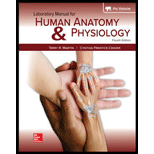
Concept explainers
Match the cranial nerves in column A with the associated functions in column B. Place the letter of your choice in the space provided.
Column A
a. Abducens
b. Accessory
c. Facial
d. Glossopharyngeal
e. Hypoglossal
f. Oculomotor
g. Olfactory
h. Optic
i. Trigeminal
j. Trochlear
k. Vagus
l. Vestibulocochlear
Column B
1. Regulates thoracic and abdominal viscera
2. Equilibrium and hearing
3. Stimulates superior oblique muscle of eye
4. Sensory impulses from teeth and face
5. Adjusts light entering eyes and eyelid opening
6. Smell
7. Controls neck and shoulder movements
8. Controls tongue movements
9. Vision
10. Stimulates lateral rectus muscle of eye
11. Sensory from anterior tongue and controls salivation and secretion of tears
12. Sensory from posterior tongue and controls salivation and swallowing
Want to see the full answer?
Check out a sample textbook solution
Chapter 30 Solutions
Laboratory Manual For Human Anatomy & Physiology
- Match the image letter showing cranial nerve dysfunction to the appropriate cranial nerve. A. occulomotor B. glossopharyngeal C. optic D. trigeminal E. facial F. hypoglossal G. abducens H. trochlea I. Accessory J. vestibulocochlear K. olfactory L. vagusarrow_forwardA 53 year old woman has a drooping eyelid. When the lid is forcefully elevated, the pupil is directed downward and laterally; there is no superior or medial movement. The pupil is dilated and unresponsive to light. Her condition is most likely caused by a lesion involving which of the following? A.superior cervical ganglion B.oculomotor nerve only C.trochlear nerve only D.trochlear and oculomotor nerves E.abducens nerve only F.abducens and oculomotor nervesarrow_forwardSelect the cranial nerves that arise from the Midbrain VIII. Vestibulococł nerve XII. Hypoglossal nerve Cranial nerve diagram VII. Facial nerve II. Optic nerve XI. Accessory nerve III. Oculomotor nerve IX. Glossopharyr nerve V. Trigeminal nerve I. Olfactory nerve X. Vagus nervearrow_forward
- Select the cranial nerves that arise from the Pons. VIII. Vestibulococł nerve I. Olfactory nerve XI. Accessory nerve VII. Facial nerve V. Trigeminal nerve X. Vagus nerve IV. Trochlear nerve IX. Glossopharyr nerve XII. Hypoglossal nerve Cranial nerve diagram II. Optic nervearrow_forwardWrite the name of each cranial nerve next to the Roman numeral representative of that nerve. Then draw a line to link each nerve to its characteristics. Some characteristics may link to VII. more than one nerve, while other nerves may have more than one characteristic. a. Mixed branch controls chewing and detects sensations in lower jaw b. Links the retina to the brain's visual cortex; III damage causes blindness in part or all of a visual field IV c. Regulates voluntary movements of the eyelid and eyeball V VI d. Damage to sensory branch causes loss of sensation in upper face VII VIII e. Governs tongue movements, swallowing, and gagging IX f. Damage causes tongue to deviate toward injured side X XI g. Damage here can cause a drooping eyelid and dilated pupil XII h. Damage causes sagging facial muscles and distorted sense of taste i. Longest and most widely distributed cranial nerve j. Concerned with hearing and balance k. Plays a key role in many heart, lung, digestive, and urinary…arrow_forwardAxons from the vestibular nerve project to each of the cranial nuclei that control the extrinsic eye muscles. A. True B. Falsearrow_forward
- Select the cranial nerves that arise from the Cerebrum XII. Hypoglossal nerve Cranial nerve diagram IV. Trochlear nerve V. Trigeminal nerve X. Vagus nerve I. Olfactory nerve XI. Accessory nerve IX. Glossopharyr nerve II. Optic nerve VI. Abducens nerve VIII. Vestibulococł nerve Cranial Nerve Functions Applying Classroom Knowledge to Clinical Practicearrow_forwardDrag the labels to the appropriate location in the figure. Reset Help Petrous part of Facial nervę Semicircular temporal (CN. VỊI) bone canals Facial nerve (N VI) Vęstibulocochlear nervé (CN. VIII) Vestibule Semicircular canals Bony labyrinth of internal ear Auditory tube Bony labyrinth of internal ear Petrous part of tomporal bone Vestibulocochlear nervo (N VIII) Auditory Vestibule tubearrow_forwardname the structure a. ventral root b. anterior white column c. posterior/ dostal root d. posterior/ doesal root ganglion e. sensory nervesarrow_forward
- Select the most appropriate structure that fits the best in the paragraph. a. pupil b. spinal cord c. optic chiasma d. cauda equina e. prefrontal cortex f. retina g. ventral h. visual cortex I. primary motor cortex j. cones k. dorsal L. lateral geniculate nucleus m. premotor area n. rods o. Broca p. visual association area q. optic tract r. bipolar cells s. medial geniculate nucleus t. Optic Light from a mysterious, blurry object enter through the_______ of the eye. That light is transmitted to the ________ activating photoreceptors which include __________ and _________. Photoreceptors are triggered sending signals through the _________ nerve. The signal from the left eye crosses at the _____________. The signal then proceeds through the _________________. The signal the reaches the_________________, which determines what type of information is being conveyed…arrow_forwardI. Olfactory nerve IV. Trochlear nerve Select the cranial nerves that are sensory. X. Vagus nerve IX. Glossopharyr nerve III. Oculomotor nerve II. Optic nerve XI. Accessory nerve VII. Facial nerve VIII. Vestibulococł nerve XII. Hypoglossal nerve Cranial nerve diagram lai Nerve Func Applying Classroom Knowledge to Clinical Practicearrow_forwardThe cranial nerve involved in feeling a toothache is thea. trochlear (IV). d. facial (VII).b. trigeminal (V). e. vestibulocochlear (VIII).c. abducens (VI).arrow_forward
 Medical Terminology for Health Professions, Spira...Health & NutritionISBN:9781305634350Author:Ann Ehrlich, Carol L. Schroeder, Laura Ehrlich, Katrina A. SchroederPublisher:Cengage Learning
Medical Terminology for Health Professions, Spira...Health & NutritionISBN:9781305634350Author:Ann Ehrlich, Carol L. Schroeder, Laura Ehrlich, Katrina A. SchroederPublisher:Cengage Learning
